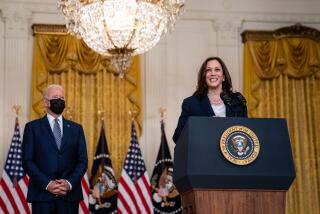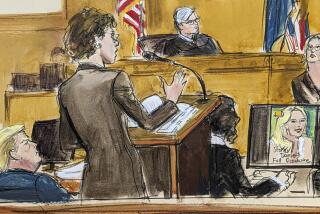Dressing eight tumultuous decades for ‘Lee Daniels’ The Butler’
Veteran costume designer Ruth Carter had her hands full with her latest feature film, “Lee Daniels’ The Butler.” In it, she tackled eight tumultuous decades of U.S. political and social history — and changing fashions — filled with dozens of national figures (including LBJ, JFK and Jackie O) and had to factor in an equally daunting number of celebrities in the cast: Jane Fonda, Vanessa Redgrave, Oprah Winfrey and, of course, Forest Whitaker in the lead role, among them.
Carter says her focus had to be stout, and she ignored the shine of the 24-karat celebrities who surrounded her, on film and in her fitting rooms. “After all,” she says, these actors “are quite serious and eager to see what I have; they’re ready for me to do what I do. They’re not coming in to be Oprah, or whomever. She’s already Oprah. They were ready for me to tell them what I was planning, so I had to be completely prepared for all of them.”
A script covering eight decades that had so many American political icons in it with so many celebrity icons to dress; it must have given you pause.
I kept looking at the cast photos on the board at the office, and I would cringe as I walked by them. It was Alan Rickman, Jane Fonda, Vanessa Redgrave and on and on. So I tried not to think about it because I felt like if I did I’d misstep. I needed to focus on the details of each president and character so that when they arrived, I could really look beyond their celebrity and look at how I could do a transformation. ... I had to get over the fact that Mork from “Mork & Mindy” [Robin Williams, who plays President Eisenhower] just came in. Robin was quite serious and eager to see what I had. Oprah was the same way.
INTERACTIVE: Best and worst Oscar moments since 2008
How much input did each actor have?
Liev Schreiber [who plays Lyndon B. Johnson] was very particular about his collar: He had a picture of Johnson that had a pinched collar under the tie, and he wanted to make sure that he had that collar exactly the same. He also had a recording of LBJ making fun of somebody in tight pants, so we thought, “He must not be in tight pants.” Everybody came with something different. John Cusack had a book he was reading about Nixon, and I went and got a videotape of his speeches and played them in the fitting room as we talked about his shirt and suits. And then once you give them the clothes, you let them go and let them create.
How involved was Daniels with the costumes?
I did have some very specific things he asked for. The hardest scene for me to watch is in the beginning and the end when Forest is sitting in the chair and he’s waiting to see President Obama. We shot that late in the schedule, and I’d already dressed him as the butler with all the tuxedos and tails, and Forest’s weight fluctuated, so I had a suit tailored for him. Forest was very confident, he felt very good in it as he got to set, but Lee shouted, “Ru-uth!” [imitating Daniels]. I thought, “What could it be? There’s only one guy on set?” He said, “I need an old man’s suit. This is not it.”
And my heart dropped, because I hadn’t had any of that from him, really, so I panicked. Both Forest and I tried to argue with Lee, but it didn’t work. So we had to find something quickly with cameramen and boom guys waiting — and I had four costumers with myself sewing up something that was 7 inches too big in the waist. I told Lee, “Please don’t shoot him from the back,” and he said, “It’s perfect, Ruth. Perfect. What are you concerned about?” And, of course, Forest is in that long shot walking from the back. He does look like an old man, the way he played it. It’s shown me I have to get over my need to make things perfect, I guess.
VIDEO: Highlights from the Envelope Screening Series
Where did those fantastic black-and-white “Super Fly” jumpsuits come from?
We made them. I’d originally designed a paisley, swirly disco jumpsuit, and I took it to Oprah, and it was too much pattern. I then found something in an Ebony magazine, a 1972 issue. I saw this ad with the girl with her Afro and the black-and-white jumpsuit and her counterpart with his black-and-white two-piece on, and I showed it to Lee and he said, “That’s it.” I wanted to have that new look that was coming from the later part of the decade, when people were taking the look of the big Afro from the civil rights era and actually turning it into a trend.
And those bright-colored ‘80s leisure suits — were those vintage?
They were real. Those were Oprah’s idea. We called all over the moon looking for them, because Forest is quite tall with long arms. I found three, and I put them in her dressing room and she picked the ugliest one. It was awful in a wonderful way.... You know immediately where you are in time.
Can you walk us through the color palettes for all the eight decades in the film?
For the sharecroppers, I wanted it to be a little void of color, very natural and organic and lots of white. Then we travel into the 1930s, and the color is still creamy but color is coming in.... As Forest starts up his climb to working at the White House, things have more color through the ‘50s and early ‘60s, with JFK and Jackie bringing in more color, until we get to the ‘60s and early ‘70s palette, with all that mustard gold, orange and green, and it’s that primary Courrèges orange, Oprah’s bright orange dress. The ‘80s had Ronald Reagan; he was real simple — dark suit, that straight-edge pocket square.... Nancy Reagan had all of those beautiful reds going on.
More to Read
Only good movies
Get the Indie Focus newsletter, Mark Olsen's weekly guide to the world of cinema.
You may occasionally receive promotional content from the Los Angeles Times.










